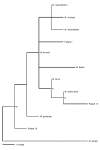Molecular analysis of sarcoidosis tissues for mycobacterium species DNA
- PMID: 12453366
- PMCID: PMC2738555
- DOI: 10.3201/eid0811.020318
Molecular analysis of sarcoidosis tissues for mycobacterium species DNA
Abstract
We performed polymerase chain reaction analysis, for Mycobacterium species 16S rRNA, rpoB, and IS6110 sequences, on 25 tissue specimens from patients with sarcoidosis and on 25 control tissue specimens consisting of mediastinal or cervical lymph nodes and lung biopsies. Mycobacterium species 16S rRNA sequences were amplified from 12 (48%) rpoB sequences and from 6 (24%) of the sarcoidosis specimens. In total, 16S rRNA or rpoB sequences were amplified from 15 sarcoidosis specimens (60%) but were not detected in any of the control tissues (p=0.00002, chi square). In three specimens, the sequences resembled Mycobacterium species other than M. tuberculosis. All specimens with sequences consistent with M. tuberculosis were negative for IS6110. We provide evidence that one of a variety of Mycobacterium species, especially organisms resembling M. tuberculosis, is found in most patients with sarcoidosis.
Figures

References
-
- Crystal RG, Bitterman PB, Rennard SI, Hance AJ, Keogh BA. Interstitial lung diseases of unknown cause. Disorders characterized by chronic inflammation of the lower respiratory tract. N Engl J Med. 1984;310:154–66. - PubMed
-
- American Thoracic Society (ATS). the European Respiratory Society (ERS) and the World Association of sarcoidosis and Other Granulomatous Disorders (WASOG). Statement on sarcoidosis. Am J Respir Crit Care Med. 1999;160:736–55. - PubMed
-
- Relman DA, Loutit JS, Schmidt TM, Falkow S, Tompkins LS. The agent of bacillary angiomatosis. An approach to the identification of uncultured pathogens. N Engl J Med. 1990;323:1573–80. - PubMed
-
- Relman DA, Schmidt TM, MacDermott RP, Falkow S. Identification of the uncultured bacillus of Whipple's disease. N Engl J Med. 1992;327:293–301. - PubMed
-
- Scadding JG, Mitchell DN. Sarcoidosis. 2nd ed. London: Chapman and Hall; 1985. p 36–41.
Publication types
MeSH terms
Substances
Grants and funding
LinkOut - more resources
Full Text Sources
Medical
